|
|
|
Sort Order |
|
|
|
Items / Page
|
|
|
|
|
|
|
| Srl | Item |
| 1 |
ID:
139469
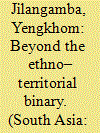

|
|
|
|
|
| Summary/Abstract |
The binary of the hills and the valley is a central theme in understanding the Northeast of India. Although the multiplicity of ‘ethnic’ groups that inhabit both the valley and the hills makes such a generalisation difficult in places like Manipur, the distinctiveness of the two groups is stressed both in everyday and scholarly articulations. Notwithstanding the popularity and power of the hill–valley binary, this article critically engages with various ‘theories’ that have been put forward on this issue and confronts their foundational claims. The intent of the paper is to argue that this binary of hill and valley is not a constructive category either historically or in the contemporary. By looking at the colonial classification between hill and valley, and the popularity of James C. Scott's recent work, I argue that there are multiple strategies adopted to maintain this binary with major implications for politics and society in Manipur and beyond.
|
|
|
|
|
|
|
|
|
|
|
|
|
|
|
|
| 2 |
ID:
139465
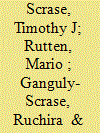

|
|
|
|
|
| Summary/Abstract |
Despite the rapid transformation of India over the past 25 years and a swathe of publications dealing with the impact of globalisation on the culture and economy of the subcontinent, and on its large metropolitan cities, we contend that relatively far less is known about the regional impacts of globalisation and the localised impacts of neo-liberal development policies. Significantly, we seek to understand and analyse how globalisation is transforming smaller, regional towns in India. Based on social scientific research exploring the development and changes taking place in two distinctive, middle towns—Anand, Gujarat and Darjeeling, West Bengal—we highlight the social and political forces at work that are re-making these towns, the local issues residents contend with, and the external drivers of change that influence the unique growth and development of these towns.
|
|
|
|
|
|
|
|
|
|
|
|
|
|
|
|
| 3 |
ID:
139461
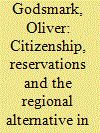

|
|
|
|
|
| Summary/Abstract |
This paper unearths an alternative paradigm through which to consider the discussions and debates between members of the Indian public, government bureaucrats and Congress Party politicians about the rights and interests of Indian citizens both before and immediately after India's Independence in 1947. It argues that much of the recent historical work on citizenship during this period has been preoccupied with issues of nationality and religious community as a result of the fallout from Partition. However, the demands and deliberations over the introduction of provincial forms of affirmative action in the all-India services at this time are indicative of a different narrative. First, many provincial representations of ‘minority’ rights often took into account differences of caste and language instead. Second, and perhaps more importantly, the term minority was employed not only to describe demographic minority status, but also to define under-represented groups in the all-India services. In doing so, these different provincial policies prioritised particular local rights to representation, in which citizenship was expressed through a regional idiom.
|
|
|
|
|
|
|
|
|
|
|
|
|
|
|
|
| 4 |
ID:
139467
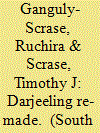

|
|
|
|
|
| Summary/Abstract |
Darjeeling today faces problems of congestion, pollution and loss of landscape aesthetics. Increased mobility and in-migration has created urban sprawl. Much of Darjeeling's architectural heritage has disappeared and many new constructions have come up to cater to the growing population, particularly the rising number of rural migrants who have been compelled to leave their homes due to diminishing rural employment. Based on ethnographic research and interviews with Darjeeling's residents, we examine the struggle for control over Darjeeling's fast-disappearing heritage, its loss of ‘charm’ as a tourist town, and its rapid transformation into a bustling, urban city reminiscent of many regional towns in India.
|
|
|
|
|
|
|
|
|
|
|
|
|
|
|
|
| 5 |
ID:
139462
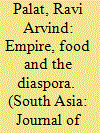

|
|
|
|
|
| Summary/Abstract |
Despite being called ‘Indian restaurants’, the family-run curry houses that are characteristic of high streets in Britain are primarily run by Bangladeshi and Pakistani migrants. This article links the evolution of these restaurants in Britain to colonial history, migration after Independence and contemporary political changes. It analyses the popularity of curry houses alongside the continuing racism meted out to the wait staff and patrons by white Britons in the context of colonial history, migration patterns and the changing industrial fortunes of India and Britain in the post-World War II era. The emergence of wealthy and highly-credentialed Indians and British-born Asians has led to the rise of upmarket eateries and to a sharp bifurcation in diasporic communities.
|
|
|
|
|
|
|
|
|
|
|
|
|
|
|
|
| 6 |
ID:
139471
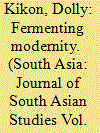

|
|
|
|
|
| Summary/Abstract |
In this article, I explore notions of modernity, citizenship, belonging and transgressions in South Asia through the fermented food, akhuni. Fermented soya beans, popularly known as akhuni in Nagaland, a state in Northeast India with a majority tribal population, has a distinct pungent aroma and taste. This food is relished across the eastern Himalayan societies, including Nagaland, but routinely causes conflict between akhuni consumers and those who find the smell revolting. In 2007, due to increasing akhuni conflict in New Delhi, the Delhi police produced a handbook t hat cautions students and workers from Northeast India and eastern Himalayan societies that they should refrain from cooking akhuni and other fermented foods. Such official directives reiterate how the state plays a significant role in legitimising or prohibiting certain foods that particular social groups in contemporary India consume, relegating these communities to a remote position in the national social and culinary order. Against the backdrop of such friction, this article examines why akhuni consumers of the eastern Himalayan societies assert that eating fermented food is an integral part of their culture and history. Conversations about eating cultures, I argue, have to be understood as expressions of resistance, negotiation and the anxieties of striving to be a modern tribal in contemporary India.
|
|
|
|
|
|
|
|
|
|
|
|
|
|
|
|
| 7 |
ID:
139466
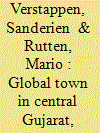

|
|
|
|
|
| Summary/Abstract |
Towns have been described as nodes of rural–urban mobility, while megacities have been described as hubs of international mobility. This paper uses the term ‘global town’ to describe a town as a hub of rural–urban and transnational migration. It draws attention to the connection between regional power dynamics, transnational migrants' ties with their home region, and urban transformation. Regionally-dominant groups can use a town to reproduce their rural power base, while less powerful communities can use a town to seek refuge from violence and marginalisation. These processes crucially affect the experiences of transnational migrants, who also participate in the transformation of the town when they ‘return home’ and buy property there, particularly after retirement. Our use of the term ‘global town’ is illustrated through a case study of Anand, Gujarat.
|
|
|
|
|
|
|
|
|
|
|
|
|
|
|
|
| 8 |
ID:
139470
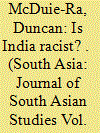

|
|
|
|
|
| Summary/Abstract |
After the 2012 Olympics, Bronze Medal-winning boxer Mary Kom achieved national celebrity status in India. As a member of the Kom tribe, a Tibeto-Burman community from the Northeast region, she has come to represent a region long considered, and self-identifying, as outside the boundaries of the Indian nation. The same week that Mary Kom returned from London, thirty thousand Northeast migrants fled Indian cities fearing racially-motivated attacks. The so-called ‘exodus’ provoked rare conversations on racism within India. During this crisis, the figure of Mary Kom was invoked continually to challenge the existence of racism in India and posit paths to better integration in India's cities. These conversations paid little attention to the brutality perpetrated by the Indian state and military in the Northeast itself and the voices that publicised this brutality. Thus, while Mary Kom has come to represent a Northeast that Indians can embrace, figures such as dissident Irom Sharmila represent a Northeast that Indians wish to forget.
|
|
|
|
|
|
|
|
|
|
|
|
|
|
|
|
| 9 |
ID:
139460
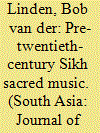

|
|
|
|
|
| Summary/Abstract |
This article discusses the canonisation and institutionalisation of Sikh sacred music (kirtan) at the courts of the ten Sikh gurus and the later Sikh maharajas in Lahore and Patiala. At the same time, it emphasises possible parallels with what happened musically at the Mughal court. Essentially, the article argues that pre-twentieth-century Sikh sacred music was Hindustani (classical) music because of its performance practice, instruments used, music theory and the interactions between Sikh court musicians and those of the Mughal and other North Indian courts, as well as of different Hindustani music lineages (gharanas). Ultimately, it underlines the importance of contextual history, for example in terms of Mughal culture, the imperial encounter and globalisation, in forming a firm understanding of continuity and change over five centuries of kirtan performance practice.
|
|
|
|
|
|
|
|
|
|
|
|
|
|
|
|
| 10 |
ID:
139464
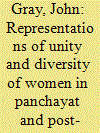

|
|
|
|
|
| Summary/Abstract |
This paper analyses the changes in the ways in which the diversity of women in Nepal has been conceived and represented from the Panchayat Democracy era in the 1960s to the current period of constitution-writing for a new federated state of Nepal. The various forms of diversity attributed to women—cultural differentiation, hierarchical differentiation, quantitative differentiation and substantive differentiation—have been and are being constructed in juxtaposition to various forms of unity—gender, universal, national unification and the ‘Third World woman’ in need of development. These varied configurations of unity–diversity have different implications for the women's movement and its quest to redress the historical subordination, oppression and exclusion that have been suffered by Nepali women.
|
|
|
|
|
|
|
|
|
|
|
|
|
|
|
|
| 11 |
ID:
139463
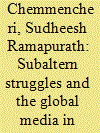

|
|
|
|
|
| Summary/Abstract |
This paper analyses the interactions between subaltern struggles and the global media, with special reference to the ways in which subalterns find opportunities in the media to make their voices heard. The paper argues that rather than losing their state of subalternity in the process of gaining a voice through media exposure, media representation reinforces the subaltern identity of the marginalised. Scrutinising the politics of representation in the media representation of the Koodankulam anti-nuclear protests and the Kashmir conflict in India, this essay draws on insights from post-colonial studies to explore new ways to read the work of the global media in their coverage of the subaltern.
|
|
|
|
|
|
|
|
|
|
|
|
|
|
|
|
| 12 |
ID:
139468
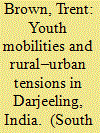

|
|
|
|
|
| Summary/Abstract |
Globalisation has introduced new sources of mobility for India's youth, yet not all youth experience mobility in the same way. The unevenness of mobility trajectories is especially visible in regional towns, where poor rural migrants and more globally connected middle-class youth occupy the same social space. To illustrate these mobility trends, this paper presents the stories of youths from various backgrounds in the town of Darjeeling, exploring different sources of mobility for rural and urban youth. While rural youth experience some forms of upward mobility as they migrate into the town, urban youth are confronted with downward mobility and are frustrated in their aspirations for professional careers and ‘modern’ lifestyles. For aspiring urban youth, upwardly-mobile rural people are seen as a threat to their privilege, blocking their mobility aspirations. This is contributing towards emerging tensions between rural and urban populations within the town.
|
|
|
|
|
|
|
|
|
|
|
|
|
|
|
|
|
|
|
|
|